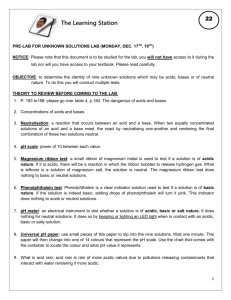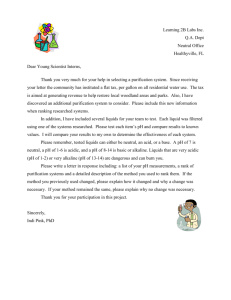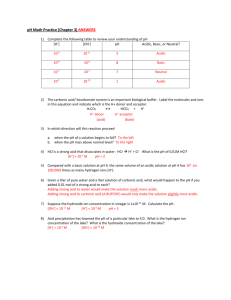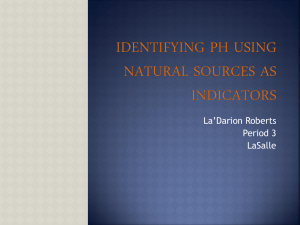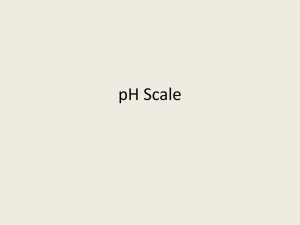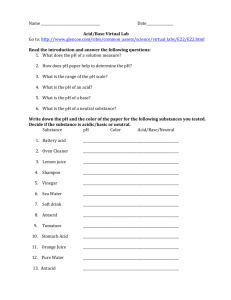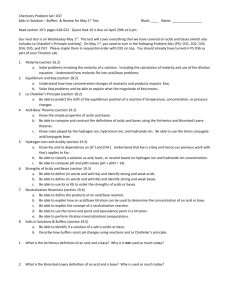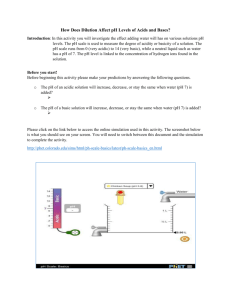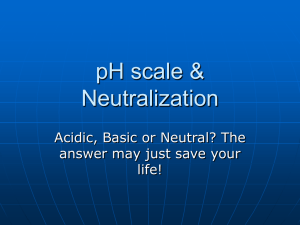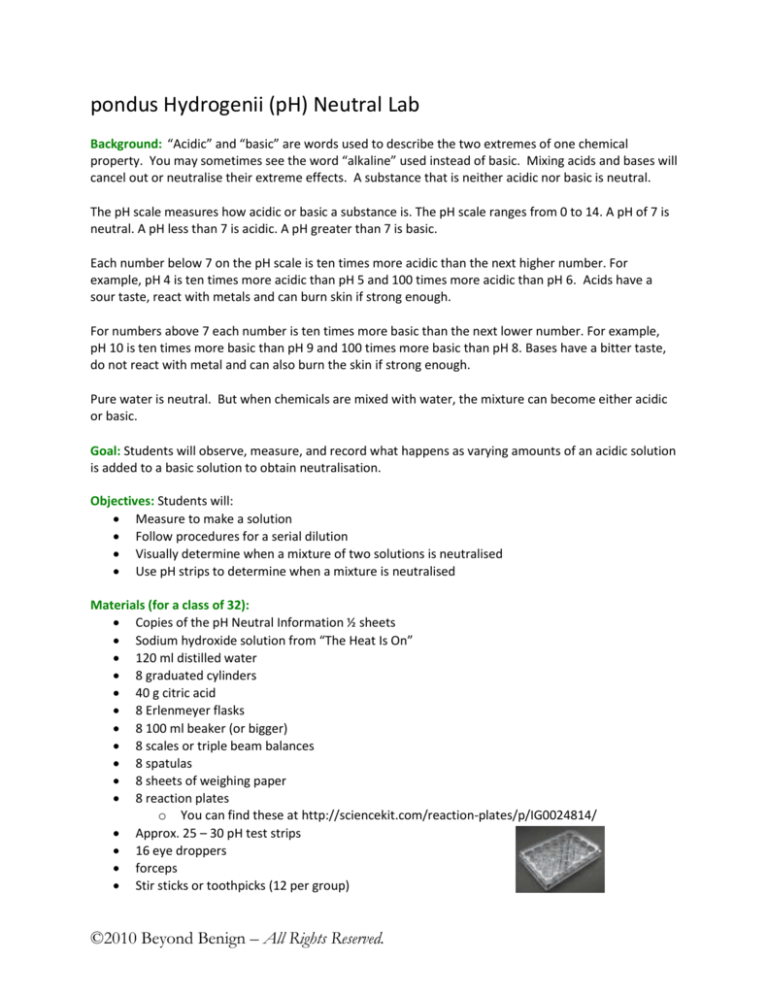
pondus Hydrogenii (pH) Neutral Lab
Background: “Acidic” and “basic” are words used to describe the two extremes of one chemical
property. You may sometimes see the word “alkaline” used instead of basic. Mixing acids and bases will
cancel out or neutralise their extreme effects. A substance that is neither acidic nor basic is neutral.
The pH scale measures how acidic or basic a substance is. The pH scale ranges from 0 to 14. A pH of 7 is
neutral. A pH less than 7 is acidic. A pH greater than 7 is basic.
Each number below 7 on the pH scale is ten times more acidic than the next higher number. For
example, pH 4 is ten times more acidic than pH 5 and 100 times more acidic than pH 6. Acids have a
sour taste, react with metals and can burn skin if strong enough.
For numbers above 7 each number is ten times more basic than the next lower number. For example,
pH 10 is ten times more basic than pH 9 and 100 times more basic than pH 8. Bases have a bitter taste,
do not react with metal and can also burn the skin if strong enough.
Pure water is neutral. But when chemicals are mixed with water, the mixture can become either acidic
or basic.
Goal: Students will observe, measure, and record what happens as varying amounts of an acidic solution
is added to a basic solution to obtain neutralisation.
Objectives: Students will:
Measure to make a solution
Follow procedures for a serial dilution
Visually determine when a mixture of two solutions is neutralised
Use pH strips to determine when a mixture is neutralised
Materials (for a class of 32):
Copies of the pH Neutral Information ½ sheets
Sodium hydroxide solution from “The Heat Is On”
120 ml distilled water
8 graduated cylinders
40 g citric acid
8 Erlenmeyer flasks
8 100 ml beaker (or bigger)
8 scales or triple beam balances
8 spatulas
8 sheets of weighing paper
8 reaction plates
o You can find these at http://sciencekit.com/reaction-plates/p/IG0024814/
Approx. 25 – 30 pH test strips
16 eye droppers
forceps
Stir sticks or toothpicks (12 per group)
©2010 Beyond Benign – All Rights Reserved.
Clear tape
32 pair of safety gloves
32 pair of safety glasses
Paper towels
30 copies pH Neutral – Student Lab Procedures
30 copies pH Neutral – Student Information
30 copies pH Neutral – Student Lab Questions
Time Required: 45–60 minute class period
Prescribed Focus Area:
4.2 the nature and practice of science
Green Chemistry Principles Addressed:
Real-time Analysis for Pollution Prevention
Inherently Safer Chemistry for Accident Prevention
Procedure:
IN CLASS
Explain to students that you are going to continue to work on shampoo.
Ask them to explain what would happen if they applied sodium hydroxide from The Heat Is On
directly onto skin.
Tell them that this is because of the lack of pH balance.
Give students the pH Neutral Information Sheet and read it
together.
o Ask students why they would want a shampoo formula
to be pH balanced
o On the back of the sheet, have students hypothesize if
sodium hydroxide is acidic or basic.
Tell students that the other substance they will use to reach a
balanced solution is citric acid.
Sample Reaction Plate from experiment
o Have students hypothesize if citric acid is acidic or basic.
Give each student the lab procedures sheet and walk through the materials and steps.
Give students the data table and lab questions.
Allow students time to complete the lab.
Have students complete the lab questions. You may have to help them with the fraction
questions!
Direct the students to clean up.
Assessment:
Completed data table showing results that truly represent the data collected.
Adhering to proper lab safety procedures
©2010 Beyond Benign – All Rights Reserved.
pH Neutral Information Sheet
“Acidic” and “basic” are words used to describe the two extremes of one chemical property. You may
sometimes see the word “alkaline” used instead of basic. Mixing acids and bases will cancel out or
neutralise their extreme effects. A substance that is neither acidic nor basic is neutral.
The pH scale measures how acidic or basic a substance is. The pH scale ranges from 0 to 14. A pH of 7 is
neutral. A pH less than 7 is acidic. A pH greater than 7 is basic.
Each number below 7 on the pH scale is ten times more acidic than the next higher number. For
example, pH 4 is ten times more acidic than pH 5 and 100 times more acidic than pH 6. Acids have a
sour taste, react with metals and can burn skin if strong enough.
For numbers above 7 each number is ten times more basic than the next lower number. For example,
pH 10 is ten times more basic than pH 9 and 100 times more basic than pH 8. Bases have a bitter taste,
do not react with metal and can also burn the skin if strong enough.
Pure water is neutral. But when chemicals are mixed with water, the mixture can become either acidic
or basic.
---------------------------------------------------------------------------------------------------------------------
pH Neutral Information Sheet
“Acidic” and “basic” are words used to describe the two extremes of one chemical property. You may
sometimes see the word “alkaline” used instead of basic. Mixing acids and bases will cancel out or
neutralise their extreme effects. A substance that is neither acidic nor basic is neutral.
The pH scale measures how acidic or basic a substance is. The pH scale ranges from 0 to 14. A pH of 7 is
neutral. A pH less than 7 is acidic. A pH greater than 7 is basic.
Each number below 7 on the pH scale is ten times more acidic than the next higher number. For
example, pH 4 is ten times more acidic than pH 5 and 100 times more acidic than pH 6. Acids have a
sour taste, react with metals and can burn skin if strong enough.
For numbers above 7 each number is ten times more basic than the next lower number. For example,
pH 10 is ten times more basic than pH 9 and 100 times more basic than pH 8. Bases have a bitter taste,
do not react with metal and can also burn the skin if strong enough.
Pure water is neutral. But when chemicals are mixed with water, the mixture can become either acidic
or basic.
©2010 Beyond Benign – All Rights Reserved.
pH Neutral Student Lab Procedures
1. Remove all materials from your lab station, paying special attention to the removal of any
plastic and aluminium materials.
2. Get a pair of safety glasses and gloves for each member of the group
Put on safety glasses or gloves
3. One member of your group should obtain your lab materials:
Sodium hydroxide solution from
“The Heat Is On”
15 ml distilled water
graduated cylinder
5 g citric acid
Erlenmeyer flask
100 ml beaker
balance
spatula
sheet of weighing paper
reaction plate
4 pH test strips
scissors
2 eye droppers
forceps
12 Stir sticks or toothpicks
clear tape
paper towel
4. Complete the following steps:
1. Use scissors to cut each pH strip in sixths. You should have at least 24 small strips when you are
finished.
2. Make sure the flask of NaOH is labeled and set aside.
3. Measure 15 ml of distilled water into a 100 ml beaker.
4. Use the balance and weighing paper to measure 5 g of citric acid.
5. Add the citric acid to the water in a 100 ml beaker and swirl to mix.
6. Use an eyedropper and carefully place 5 drops of NaOH in each well of the reaction plate.
7. Using a clean eyedropper, add one drop of citric acid to the NaOH in well one.
8. Add two drops to the NaOH in well two.
9. Add three drops to well three and so on.
10. Use a clean stir stick or toothpick to mix each of the wells.
11. Use the forceps to carefully drop a segment of pH strip into each well.
12. Remove the segments with the forceps and place on the pH Neutral Student Data Table beside
the appropriate well number.
13. Indicate the pH for each well in the appropriate column.
14. Make any observations, considering color, consistency, viscosity, density, etc.
15. Indicate where neutralisation occurred, and tape the test strips in place.
16. Clean up according to the directions from your teacher.
©2010 Beyond Benign – All Rights Reserved.
pH Neutral Student Data Table
Well #
1
2
3
4
5
6
7
8
9
10
11
12
13
14
15
16
17
18
19
20
21
22
23
24
Test Strip
pH
Observations
pH Neutral Student Lab Questions
1. Which substance is basic?
2. Which substance is acidic?
3. In the well that is pH neutral;
a. How many drops of sodium hydroxide are in it? ____________
b. Write the fraction that represents the amount of sodium hydroxide in the
solution ____________
c. How many drops of citric acid are in it? ____________
d. Write the fraction that represents the amount of citric acid in the solution
____________
4. What is the ratio of sodium hydroxide to citric acid in a neutral solution? ____________
pH Neutral Student Lab Questions – Teacher Key
1. Which substance is basic?
The sodium hydroxide (NaOH) is basic.
2. Which substance is acidic?
The citric acid is acidic.
3. In the well that is pH neutral…
It will be neutral in well 13 (approximately).
a. How many drops of sodium hydroxide are in it? 5
b. Write the fraction that represents the amount of sodium hydroxide in the
solution 5/18
c. How many drops of citric acid are in it? 13
d. Write the fraction that represents the amount of citric acid in the solution 13/18
4. What is the ratio of sodium hydroxide to citric acid in a neutral solution?
5 NaOH : 13 citric

